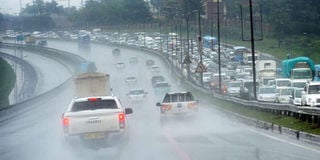Weatherman issues heavy rain alert

Motorists drive through the rain on Thika Highway, Nairobi. PHOTO | FILE | NATION MEDIA GROUP
What you need to know:
- Areas likely to be affected include Nairobi, Mombasa, Kisumu, Siaya, Nyeri, Kiambu, Nyandarua, Laikipia, Murang’a, Embu, among others.
The Kenya Meteorological Department has warned Kenyans to brace themselves for heavy rainfall of more than 20mm in 24 hours which is expected in several regions, including coast and Nairobi, from January 23.
“The rainfall is expected to spread to southeastern, coast and northeastern regions from Friday January 24 and intensify to 30 mm in 24 hours from Saturday 25th to Monday 27th over the coast, southeastern, central including Nairobi, western and northeastern regions,” said the weatherman in a statement.
The department further indicated that the coverage and intensity is expected to reduce over southeastern, northeastern and coast from January 28.
However, the western and central Rift Valley regions are expected to receive more than 40 mm of rainfall in 24 hours on January 28 and 29.
Rainfall is projected to reduce as from January 30 in most parts of the country.
Areas likely to be affected include Nairobi, Nyeri, Kiambu, Nyandarua, Laikipia, Murang’a, Embu, Kirinyaga, Tharaka-Nithi, Machakos, Makueni, Taita-Taveta, Busia, Kisii, Nyamira and Migori.
Others are Kericho, Bomet, Nakuru, Baringo, Samburu, West Pokot, Narok, Nandi, Trans Nzoia, Uasin Gishu, Elgeyo Marakwet, Bungoma, Vihiga, Homa Bay, Kisumu, Siaya, Kakamega, parts of Kajiado, Isiolo, Marsabit, Mandera, Wajir, Mombasa, Kwale, Kilifi, parts of Tana River and Lamu.
Residents in these areas have been advised to be on the lookout for flash floods and avoid driving through or walking in moving water or open fields and avoid sheltering under trees.
“They are advised ... not to shelter under trees and near grilled windows to minimise exposure to lightning strikes,” explained the Meteorological Department.
Updates will be provided promptly if there are any changes in the rainfall patterns, the weatherman said.
TRAIL OF DESTRUCTION
Floods, lightning strikes and landslides were witnessed recently in various parts of the country, leaving behind a trail of destruction.
According to Augustine Kiptum, the principal meteorologist at Met Department, the intensity of the rainfall received in December last year was due to the Indian Ocean Dipole (IOD), also known as Indian Niño, which was triggered by the irregular fluctuation of sea-surface temperatures.
As such, the western Indian Ocean that borders the East African shores became alternately warmer and then colder compared to the eastern part of the ocean, leading to more storm clouds and, as a result, more rainfall in the mainland.
More than 50 people lost their lives in the West Pokot landslide due to heavy rains in November-December.
In another incident, three pupils lost their lives and 27 others were injured in Mkulima Primary School in Kuresoi after lighting struck their school last week.
At least 220 families in Kakola village around Ombaka in Ahero were forced to move out of their homes and camped at St John Paul II Nyamasao Primary School following heavy downpour. The heavy rains raised water levels in Lake Victoria resulting in a backflow around Ombaka in Kakola village.
Two women also drowned while trying to cross River Magada in East Seme Ward, Kisumu County.
Farmers in Ndhiwa and Rachuonyo North sub-counties in Homa Bay counted losses after their crops were swept away by the floods which occurred after River Oyombo in Ndhiwa and River Miriu in Rachuonyo North bust their banks.
The heavy rainfall also saw food prices in Nyeri County go up after farmers were left grappling with heavy losses.
Potato prices increased by 38 percent for a 17kg bucket from Sh400 to Sh550. Tomato prices also increased by from Sh60 to Sh80 per kilogramme.




